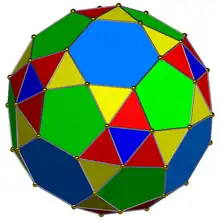| Pentahexagonal pyritoheptacontatetrahedron | |
|---|---|
 | |
| Type | Near-miss Johnson solid Symmetrohedron |
| Faces | 74: 6 hexagons 12 pentagons 8+24+24 non-equilateral triangles |
| Edges | 132 |
| Vertices | 60 |
| Vertex configuration | 3.3.5.6 3.5.3.6 3.3.3.3.5 |
| Symmetry group | Th, [3+,4], (3*2), order 24 |
| Rotation group | T, [3,3]+, (332), order 12 |
| Properties | convex |
| Net | |
 | |

Model built with polydron
In geometry, a pentahexagonal pyritoheptacontatetrahedron is a near-miss Johnson solid with pyritohedral symmetry. This near-miss was discovered by Mason Green in 2006. It has 6 hexagonal faces, 12 pentagonal faces, and 56 triangles in 3 symmetry positions. Mason calls it a hexagonally expanded snubbed dodecahedron.[1]
With regular hexagons and pentagons it is a symmetrohedron.[2] The triangles are not equilateral, with triangle-triangle edges compressed by 1.8%.
It has 3 vertex configurations, 3.3.5.6, 3.5.3.6, 3.3.3.3.5, with the last shared in the snub dodecahedron.
See also
- Tetrated dodecahedron has tetrahedral symmetry
References
- ↑ Near Misses based on dodecahedra
- ↑ Kaplan, Craig S.; Hart, George W. (2001), "Symmetrohedra: Polyhedra from Symmetric Placement of Regular Polygons", Bridges: Mathematical Connections in Art, Music and Science (PDF).
External links
This article is issued from Wikipedia. The text is licensed under Creative Commons - Attribution - Sharealike. Additional terms may apply for the media files.